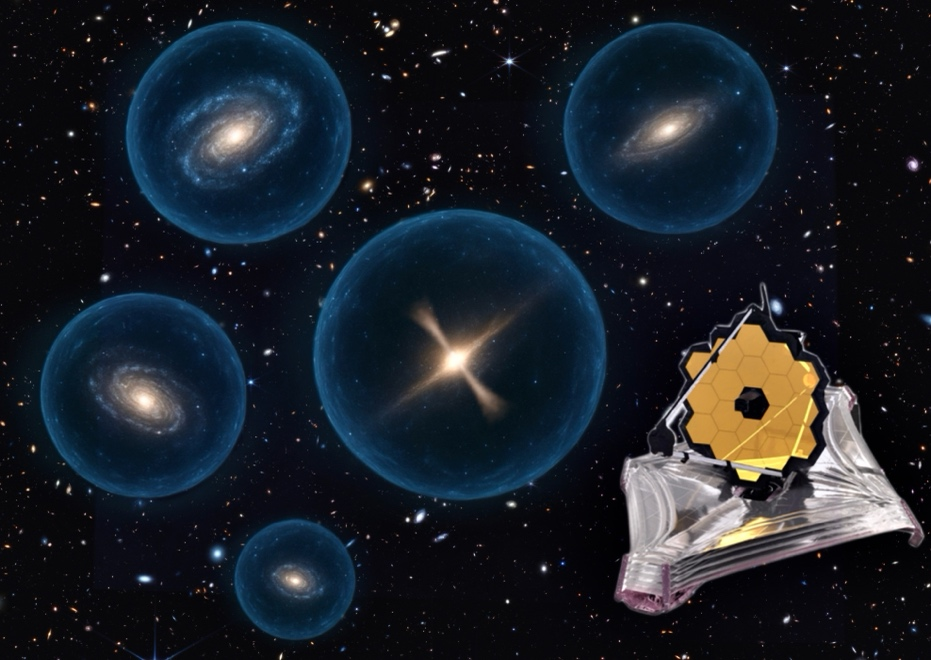 A team led by Professor Linhua Jiang and PhD student Danyang Jiang at the Kavli Institute for Astronomy and Astrophysics and School of Physics at Peking University used the James Webb Space Telescope (JWST) to conclusively rule out the possibility of AGNs being the dominant ionizing sources during the peak period of reionization, a transformative epoch in the history of our universe. Star-forming galaxies must have provided the primary ionizing photons for cosmic reionization The study, titled “AGNs ruled out as the dominant source of cosmic reionization,” was published online on October 7, 2025, in Nature Astronomy. A team led by Professor Linhua Jiang and PhD student Danyang Jiang at the Kavli Institute for Astronomy and Astrophysics and School of Physics at Peking University used the James Webb Space Telescope (JWST) to conclusively rule out the possibility of AGNs being the dominant ionizing sources during the peak period of reionization, a transformative epoch in the history of our universe. Star-forming galaxies must have provided the primary ionizing photons for cosmic reionization The study, titled “AGNs ruled out as the dominant source of cosmic reionization,” was published online on October 7, 2025, in Nature Astronomy.
|
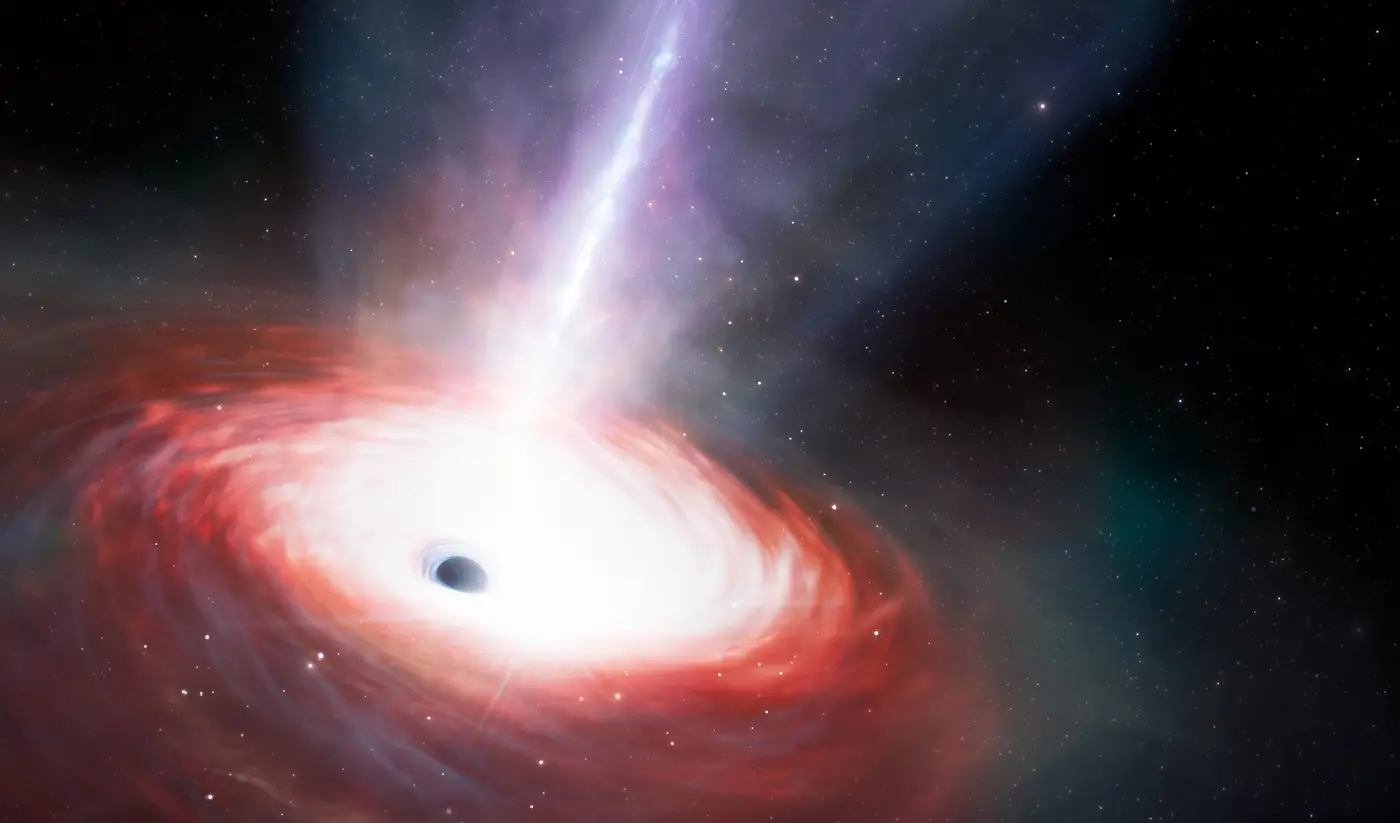 Quasars are among the brightest beacons in the Universe, powered by supermassive black holes that swallow gas at their centers. Although they shine across billions of light-years, their extreme distances and tiny sizes make it very difficult to see what is happening in the immediate surroundings of the black hole itself. Now, for the first time, an international team of astronomers, including at PKU, have managed to directly resolve the inner structure of a quasar at redshift 4—when the Universe was less than 1.5 billion years old—opening a new window into how black holes grew in the early cosmos. Quasars are among the brightest beacons in the Universe, powered by supermassive black holes that swallow gas at their centers. Although they shine across billions of light-years, their extreme distances and tiny sizes make it very difficult to see what is happening in the immediate surroundings of the black hole itself. Now, for the first time, an international team of astronomers, including at PKU, have managed to directly resolve the inner structure of a quasar at redshift 4—when the Universe was less than 1.5 billion years old—opening a new window into how black holes grew in the early cosmos.
|
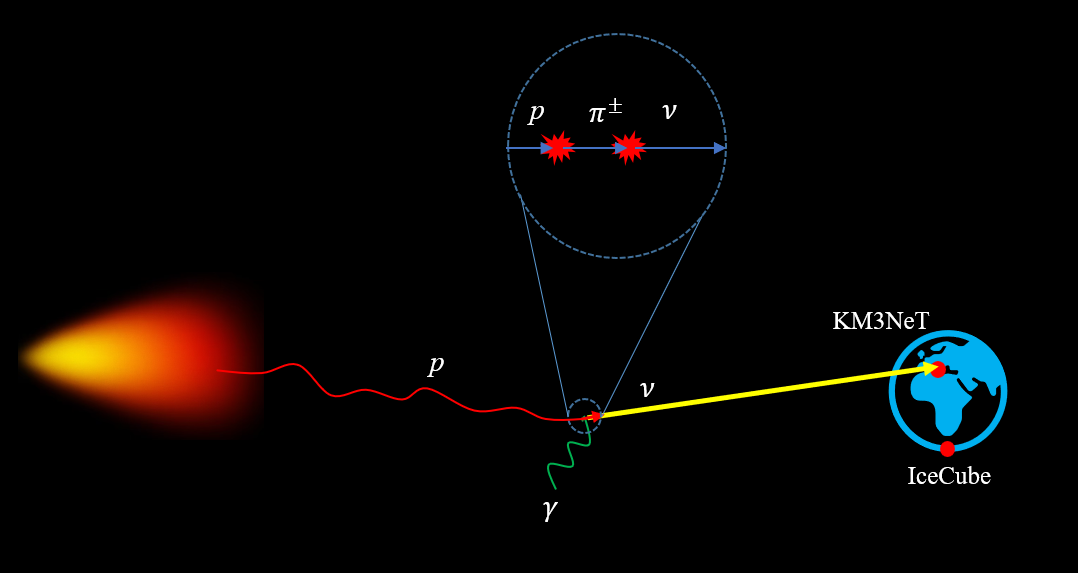 For decades, very high-energy neutrinos were thought to be produced by interactions between ultra-high-energy cosmic rays and photons from the cosmic microwave background. These so-called cosmogenic neutrinos should produce a diffuse, ultra-high-energy neutrino background in the universe. Recently, the neutrino telescope KM3NeT, which is only partly constructed so far, detected a neutrino event, named KM3-230213A, with an energy of about 220 PeV. The detection of such a high-energy neutrino event is in tension with the non-detection of such high-energy neutrino events by IceCube, which is much larger and has operated over a longer period of time. A recent work led by Prof Zhuo Li from Peking University suggests that the event may have instead originated from a beam of ultra-high-energy cosmic rays emitted by a transient rather than the diffuse neutrino background. For decades, very high-energy neutrinos were thought to be produced by interactions between ultra-high-energy cosmic rays and photons from the cosmic microwave background. These so-called cosmogenic neutrinos should produce a diffuse, ultra-high-energy neutrino background in the universe. Recently, the neutrino telescope KM3NeT, which is only partly constructed so far, detected a neutrino event, named KM3-230213A, with an energy of about 220 PeV. The detection of such a high-energy neutrino event is in tension with the non-detection of such high-energy neutrino events by IceCube, which is much larger and has operated over a longer period of time. A recent work led by Prof Zhuo Li from Peking University suggests that the event may have instead originated from a beam of ultra-high-energy cosmic rays emitted by a transient rather than the diffuse neutrino background.
|
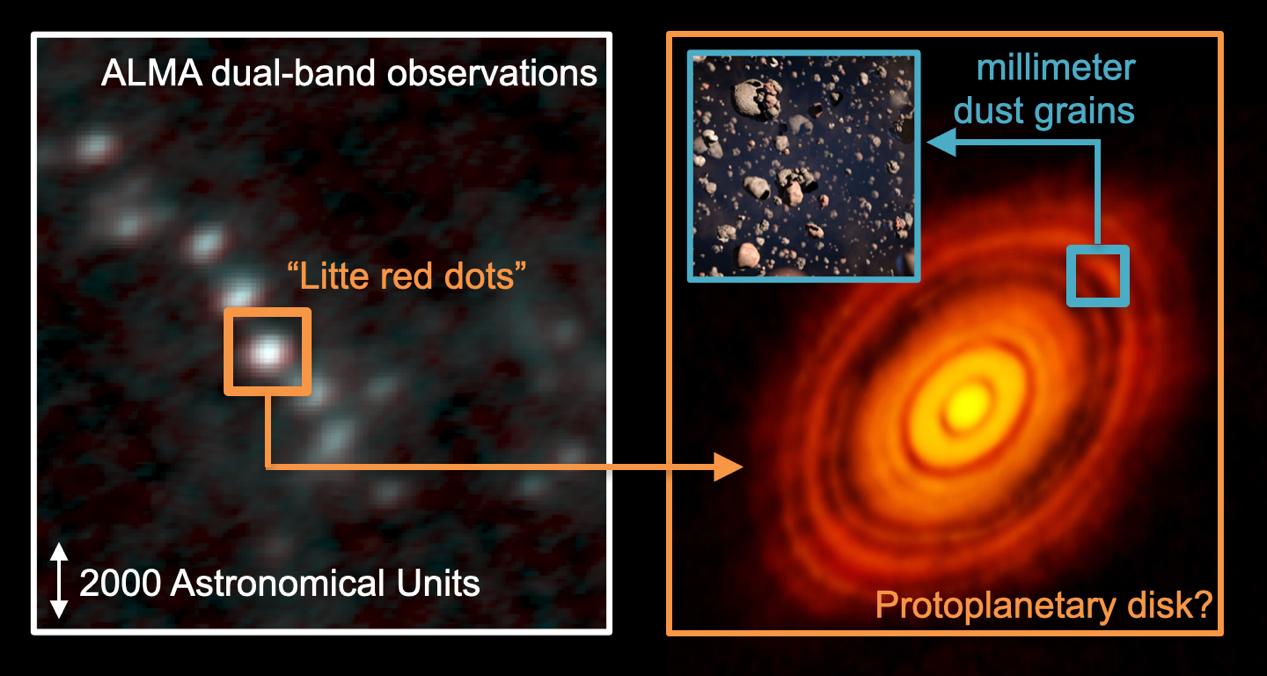 Are We Alone? And Where Do We Come From? An international team of researchers led by Peking University PhD student Fengwei Xu has conducted a most sensitive, highest-resolution, and dual-band survey of three distant molecular clouds in the Milky Way Galactic center. Equipped with sharp color-discerning "eyes", they have discovered more than 300 protoplanetary disk candidates, some of which could represent the early stages of our own solar system. The studies inspire further investigations of protoplanetary disk in various environment. Are We Alone? And Where Do We Come From? An international team of researchers led by Peking University PhD student Fengwei Xu has conducted a most sensitive, highest-resolution, and dual-band survey of three distant molecular clouds in the Milky Way Galactic center. Equipped with sharp color-discerning "eyes", they have discovered more than 300 protoplanetary disk candidates, some of which could represent the early stages of our own solar system. The studies inspire further investigations of protoplanetary disk in various environment.
|
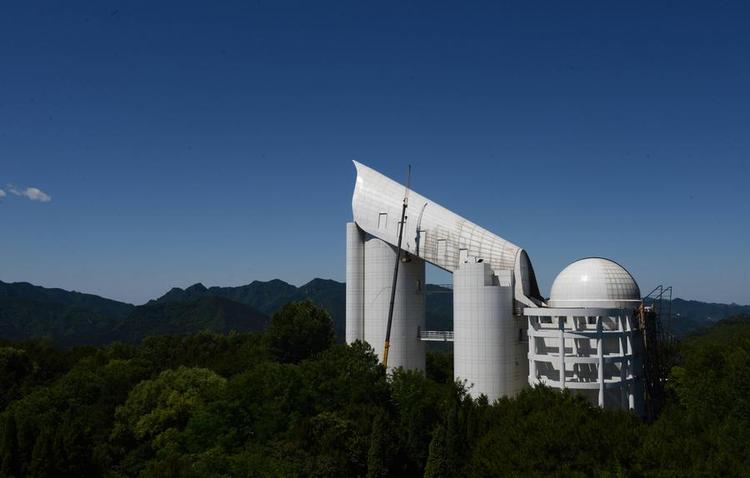 A group of astronomers has found over 1,300 new quasars behind the Galactic plane by using China's Large Sky Area Multi-Object Fiber Spectroscopic Telescope (LAMOST), and the scientists said the results shed new light on some hot issues of cosmic research. A group of astronomers has found over 1,300 new quasars behind the Galactic plane by using China's Large Sky Area Multi-Object Fiber Spectroscopic Telescope (LAMOST), and the scientists said the results shed new light on some hot issues of cosmic research.
|
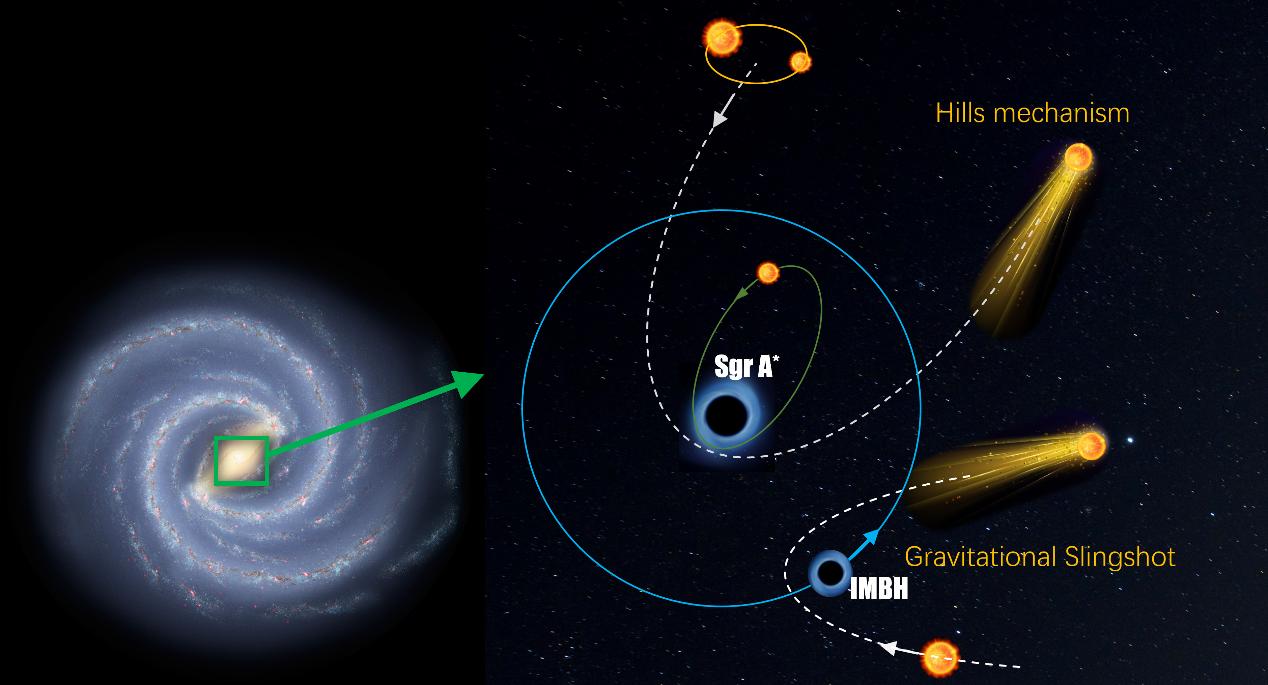 A research team led by Professor Liu Fukun from the Department of Astronomy at the School of Physics of Peking University and the Kavli Institute for Astronomy and Astrophysics recently discovered that the supermassive black hole at the center of our galaxy, Sgr A*, merged with an intermediate black hole about 10 million years ago. When stars get too close to a supermassive black hole, they can be thrown out at high speeds and become a hypervelocity star. By analyzing the velocity distribution of these hypervelocity stars in the Milky Way halo, the team found that between 50 and 250 million years ago, an intermediate-mass black hole of approximately 15,000 times the mass of the Sun existed near the supermassive black hole Sgr A* at the Galactic center. A research team led by Professor Liu Fukun from the Department of Astronomy at the School of Physics of Peking University and the Kavli Institute for Astronomy and Astrophysics recently discovered that the supermassive black hole at the center of our galaxy, Sgr A*, merged with an intermediate black hole about 10 million years ago. When stars get too close to a supermassive black hole, they can be thrown out at high speeds and become a hypervelocity star. By analyzing the velocity distribution of these hypervelocity stars in the Milky Way halo, the team found that between 50 and 250 million years ago, an intermediate-mass black hole of approximately 15,000 times the mass of the Sun existed near the supermassive black hole Sgr A* at the Galactic center.
|
 A team led by Professor Linhua Jiang and PhD student Danyang Jiang at the Kavli Institute for Astronomy and Astrophysics and School of Physics at Peking University used the James Webb Space Telescope (JWST) to conclusively rule out the possibility of AGNs being the dominant ionizing sources during the peak period of reionization, a transformative epoch in the history of our universe. Star-forming galaxies must have provided the primary ionizing photons for cosmic reionization The study, titled “AGNs ruled out as the dominant source of cosmic reionization,” was published online on October 7, 2025, in Nature Astronomy.
A team led by Professor Linhua Jiang and PhD student Danyang Jiang at the Kavli Institute for Astronomy and Astrophysics and School of Physics at Peking University used the James Webb Space Telescope (JWST) to conclusively rule out the possibility of AGNs being the dominant ionizing sources during the peak period of reionization, a transformative epoch in the history of our universe. Star-forming galaxies must have provided the primary ionizing photons for cosmic reionization The study, titled “AGNs ruled out as the dominant source of cosmic reionization,” was published online on October 7, 2025, in Nature Astronomy.
 Quasars are among the brightest beacons in the Universe, powered by supermassive black holes that swallow gas at their centers. Although they shine across billions of light-years, their extreme distances and tiny sizes make it very difficult to see what is happening in the immediate surroundings of the black hole itself. Now, for the first time, an international team of astronomers, including at PKU, have managed to directly resolve the inner structure of a quasar at redshift 4—when the Universe was less than 1.5 billion years old—opening a new window into how black holes grew in the early cosmos.
Quasars are among the brightest beacons in the Universe, powered by supermassive black holes that swallow gas at their centers. Although they shine across billions of light-years, their extreme distances and tiny sizes make it very difficult to see what is happening in the immediate surroundings of the black hole itself. Now, for the first time, an international team of astronomers, including at PKU, have managed to directly resolve the inner structure of a quasar at redshift 4—when the Universe was less than 1.5 billion years old—opening a new window into how black holes grew in the early cosmos.
 For decades, very high-energy neutrinos were thought to be produced by interactions between ultra-high-energy cosmic rays and photons from the cosmic microwave background. These so-called cosmogenic neutrinos should produce a diffuse, ultra-high-energy neutrino background in the universe. Recently, the neutrino telescope KM3NeT, which is only partly constructed so far, detected a neutrino event, named KM3-230213A, with an energy of about 220 PeV. The detection of such a high-energy neutrino event is in tension with the non-detection of such high-energy neutrino events by IceCube, which is much larger and has operated over a longer period of time. A recent work led by Prof Zhuo Li from Peking University suggests that the event may have instead originated from a beam of ultra-high-energy cosmic rays emitted by a transient rather than the diffuse neutrino background.
For decades, very high-energy neutrinos were thought to be produced by interactions between ultra-high-energy cosmic rays and photons from the cosmic microwave background. These so-called cosmogenic neutrinos should produce a diffuse, ultra-high-energy neutrino background in the universe. Recently, the neutrino telescope KM3NeT, which is only partly constructed so far, detected a neutrino event, named KM3-230213A, with an energy of about 220 PeV. The detection of such a high-energy neutrino event is in tension with the non-detection of such high-energy neutrino events by IceCube, which is much larger and has operated over a longer period of time. A recent work led by Prof Zhuo Li from Peking University suggests that the event may have instead originated from a beam of ultra-high-energy cosmic rays emitted by a transient rather than the diffuse neutrino background.
 Are We Alone? And Where Do We Come From? An international team of researchers led by Peking University PhD student Fengwei Xu has conducted a most sensitive, highest-resolution, and dual-band survey of three distant molecular clouds in the Milky Way Galactic center. Equipped with sharp color-discerning "eyes", they have discovered more than 300 protoplanetary disk candidates, some of which could represent the early stages of our own solar system. The studies inspire further investigations of protoplanetary disk in various environment.
Are We Alone? And Where Do We Come From? An international team of researchers led by Peking University PhD student Fengwei Xu has conducted a most sensitive, highest-resolution, and dual-band survey of three distant molecular clouds in the Milky Way Galactic center. Equipped with sharp color-discerning "eyes", they have discovered more than 300 protoplanetary disk candidates, some of which could represent the early stages of our own solar system. The studies inspire further investigations of protoplanetary disk in various environment.
 A group of astronomers has found over 1,300 new quasars behind the Galactic plane by using China's Large Sky Area Multi-Object Fiber Spectroscopic Telescope (LAMOST), and the scientists said the results shed new light on some hot issues of cosmic research.
A group of astronomers has found over 1,300 new quasars behind the Galactic plane by using China's Large Sky Area Multi-Object Fiber Spectroscopic Telescope (LAMOST), and the scientists said the results shed new light on some hot issues of cosmic research.
 A research team led by Professor Liu Fukun from the Department of Astronomy at the School of Physics of Peking University and the Kavli Institute for Astronomy and Astrophysics recently discovered that the supermassive black hole at the center of our galaxy, Sgr A*, merged with an intermediate black hole about 10 million years ago. When stars get too close to a supermassive black hole, they can be thrown out at high speeds and become a hypervelocity star. By analyzing the velocity distribution of these hypervelocity stars in the Milky Way halo, the team found that between 50 and 250 million years ago, an intermediate-mass black hole of approximately 15,000 times the mass of the Sun existed near the supermassive black hole Sgr A* at the Galactic center.
A research team led by Professor Liu Fukun from the Department of Astronomy at the School of Physics of Peking University and the Kavli Institute for Astronomy and Astrophysics recently discovered that the supermassive black hole at the center of our galaxy, Sgr A*, merged with an intermediate black hole about 10 million years ago. When stars get too close to a supermassive black hole, they can be thrown out at high speeds and become a hypervelocity star. By analyzing the velocity distribution of these hypervelocity stars in the Milky Way halo, the team found that between 50 and 250 million years ago, an intermediate-mass black hole of approximately 15,000 times the mass of the Sun existed near the supermassive black hole Sgr A* at the Galactic center.
